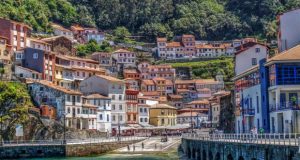How pilgrims benefit rural communities
The last World Trails Conference took place in Santiago de Compostela in September 2018. There were many lessons learnt during the three day event but only one that inspired the article you are about to read. Why should we promote active walking holidays such as The Camino de Santiago?
The Camino is growing more popular as it helps you reconnect with nature and rural areas which we have distanced ourselves from over the last fifty years due to our busy city lives and the advancement of technology. This separation from our natural way of living a thousand years ago is causing a crave for nature and we are embracing the idea of exploring our inner selves while enjoying an active walking holiday. This is the Slow Tourism model, a form of responsible travel that has deeper economic implications that you may think. Let’s explore them!

Promoting this type of holiday over traditional beach holidays (Mass Tourism) has a major impact on the local economy. When we go to a beach resort in the Costa del Sol for two weeks, money concentrates mainly in two pockets. First, a single large hotel chain whose owners usually do not live in the community where you spend your money (ie resorts in Marbella); and secondly, in the mass media marketing campaigns ran by the large Tour Operators that convince us all to go to the same places every year.
When you embark on the Camino, either organised by yourself or a small Camino specialist, your money spreads over the region you walk. On a 14 day Camino trip you will stay in thirteen different hotels, most of them locally owned, and you will spend money on food and drinks in a different village or town every day, helping boost their small local economy. Your impact in these rural populations is huge and your money truly makes a difference. Research by the Economic Analysis Department of the University of Santiago 2018, presented during the conference, showed that some small municipalities along the Camino achieved a GDP increase of as much as 21% thanks to Pilgrims. This was the case in Tricastela, a small village with a population of 680 people, located in Galicia in the north west of Spain. The median GDP increase was 10% in several councils along the French Way in towns such as Portomarín, Pedrafita and O Pino to name but a few.

The Camino also creates many jobs locally as pilgrims spend their money on labor intensive sectors such as cafe-bars, restaurants, small hotels and rural houses. This multiplies by the fact that, as you are moving an average of 22kms per day, you will have your breakfast, lunch and dinner cooked and served by different people every time as opposed to the same cooks and waiters in the all-inclusive resorts of the Costa del Sol. The Camino helps create local jobs at a higher rate, per euro spent, than any other type of holiday. As a consequence, in the Slow Tourism model, 84% of jobs are created locally compared to only 36% in the Mass Tourism model.
Is this local GDP increase and jobs creation helping only a few or is it benefitting the entire town/village? Although the major winners are those who are involved in the tourism sector, either the business owners in the town that cater for pilgrims or employees who work in these businesses, there is a domino effect that benefits the community. Let’s see why this happens.

A study, by Professor Shay Rabineau from Binghamton University in New York, highlights the amount of money that stays in the local economy on hiking holidays. His study compared a specific hiking trail in the Middle East with the Dead Sea Mass Tourism. It showed that 65% of the money spent in the Slow Tourism model stays in the local economy versus 14% in the Mass Tourism model. If we transpose these figures to our example, the Camino de Santiago, the repercussions are clear. When you spend €1,000 on your Camino holidays, €650 stays with the people who work in tourism in these towns and villages. Afterwards, these local people spend your money again throughout the year in local shops such as in the butchers, bakery, grocery shop and clothes shop. This is the main reason why the people who live in villages on the Camino believe that they are better off overall even though they may not be working directly in the tourism sector. In contrast, when you spend €1,000 in the beach resort holiday, only €140 stays with locals, mainly the employees of the large hotel who live in the town. The impact they can make when shopping locally is far less important.
This is why Magic Hill Holidays, as an Irish responsible travel company, specialised in the Camino, is helping to promote active hiking holidays around the world.
Written by Victor Delgado, Director of Magic Hill Holidays. Magic Hill Holidays is an Irish Camino Specialist Company that provides organised - hassle free - Camino trips. Click on www.magichillholidays.com for further details.
Comments
Post a Comment